Food Safety Management Report: Business Development in Food Industry
VerifiedAdded on 2020/06/06
|10
|3216
|25
Report
AI Summary
This report examines food safety management within the context of the Hawksmoor restaurant chain. It begins by outlining the controls necessary to prevent physical and chemical contamination, and then discusses characteristics of food poisoning and foodborne infections, along with methods to control foodborne illnesses. The report categorizes food spoilage agents and explores various food preservation methods, analyzing their effectiveness. Key steps in a temperature control system are detailed, along with safe food storage practices, the importance of personal hygiene, and the evaluation of cleaning and disinfection processes. Problems associated with pest control, the need for hygienic design and construction of food premises, and the importance of training as a quality assurance mechanism are also addressed. Finally, the report concludes with a food hazard risk assessment, providing a comprehensive overview of food safety management practices relevant to the food industry and Hawksmoor specifically. This report is contributed by a student and available on Desklib.
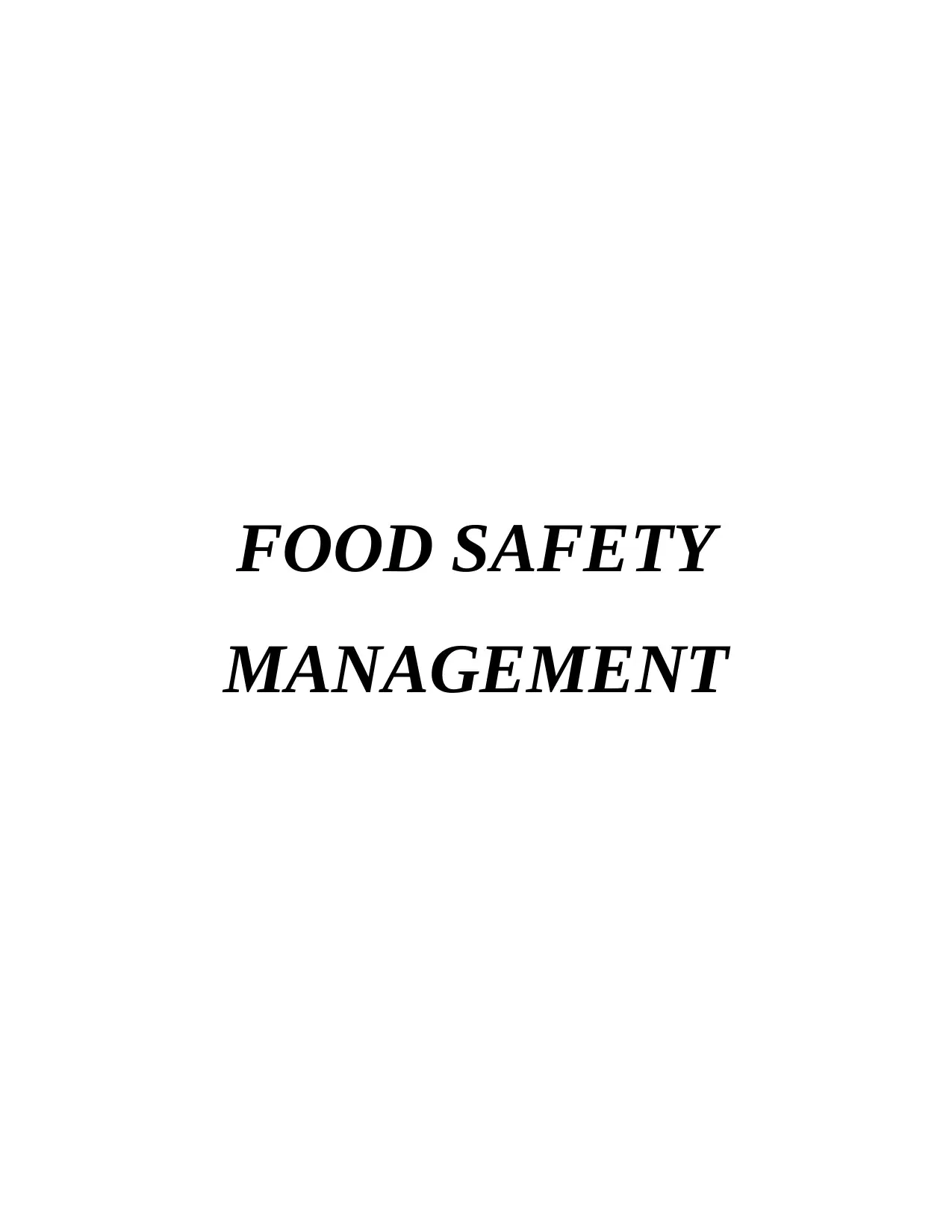
FOOD SAFETY
MANAGEMENT
MANAGEMENT
Paraphrase This Document
Need a fresh take? Get an instant paraphrase of this document with our AI Paraphraser
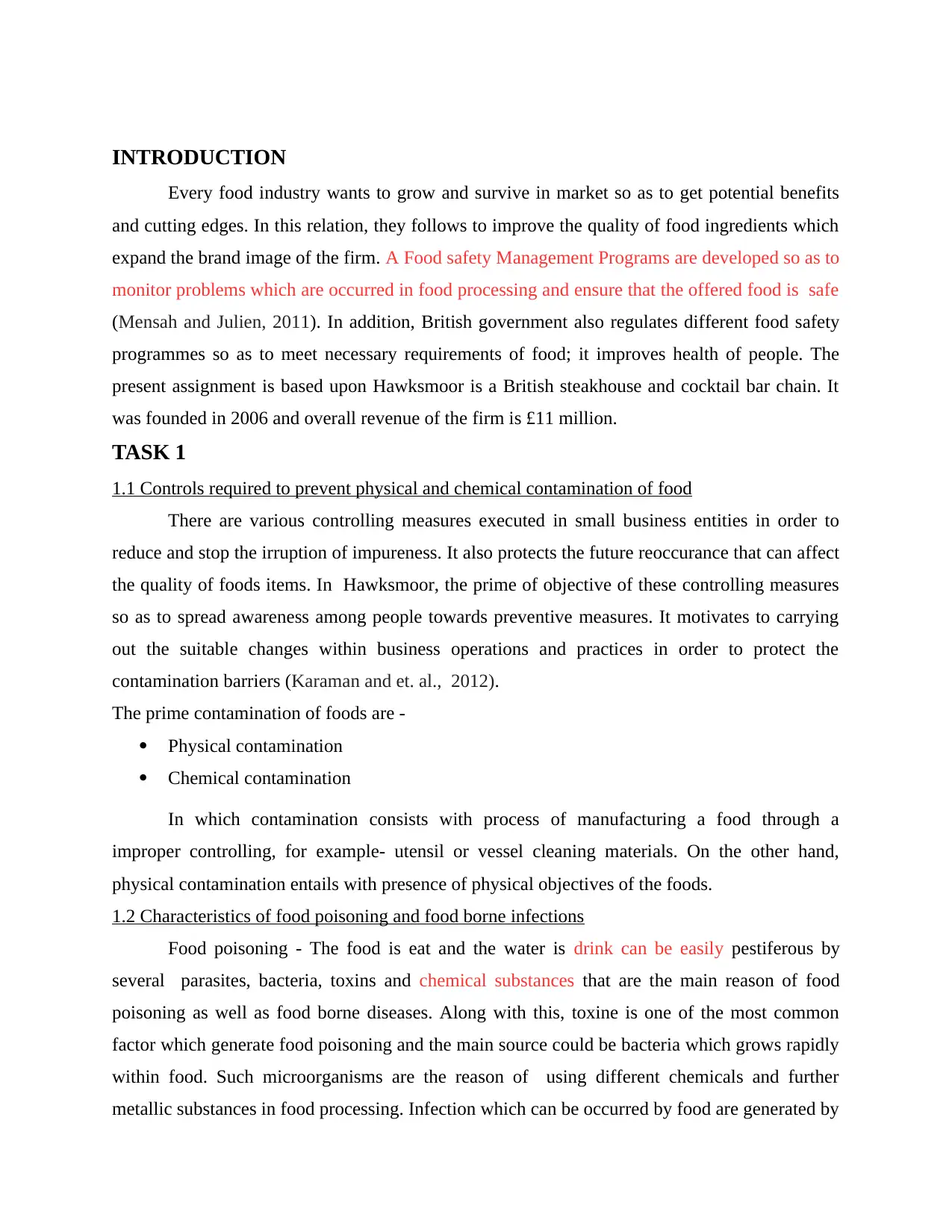
INTRODUCTION
Every food industry wants to grow and survive in market so as to get potential benefits
and cutting edges. In this relation, they follows to improve the quality of food ingredients which
expand the brand image of the firm. A Food safety Management Programs are developed so as to
monitor problems which are occurred in food processing and ensure that the offered food is safe
(Mensah and Julien, 2011). In addition, British government also regulates different food safety
programmes so as to meet necessary requirements of food; it improves health of people. The
present assignment is based upon Hawksmoor is a British steakhouse and cocktail bar chain. It
was founded in 2006 and overall revenue of the firm is £11 million.
TASK 1
1.1 Controls required to prevent physical and chemical contamination of food
There are various controlling measures executed in small business entities in order to
reduce and stop the irruption of impureness. It also protects the future reoccurance that can affect
the quality of foods items. In Hawksmoor, the prime of objective of these controlling measures
so as to spread awareness among people towards preventive measures. It motivates to carrying
out the suitable changes within business operations and practices in order to protect the
contamination barriers (Karaman and et. al., 2012).
The prime contamination of foods are -
Physical contamination
Chemical contamination
In which contamination consists with process of manufacturing a food through a
improper controlling, for example- utensil or vessel cleaning materials. On the other hand,
physical contamination entails with presence of physical objectives of the foods.
1.2 Characteristics of food poisoning and food borne infections
Food poisoning - The food is eat and the water is drink can be easily pestiferous by
several parasites, bacteria, toxins and chemical substances that are the main reason of food
poisoning as well as food borne diseases. Along with this, toxine is one of the most common
factor which generate food poisoning and the main source could be bacteria which grows rapidly
within food. Such microorganisms are the reason of using different chemicals and further
metallic substances in food processing. Infection which can be occurred by food are generated by
Every food industry wants to grow and survive in market so as to get potential benefits
and cutting edges. In this relation, they follows to improve the quality of food ingredients which
expand the brand image of the firm. A Food safety Management Programs are developed so as to
monitor problems which are occurred in food processing and ensure that the offered food is safe
(Mensah and Julien, 2011). In addition, British government also regulates different food safety
programmes so as to meet necessary requirements of food; it improves health of people. The
present assignment is based upon Hawksmoor is a British steakhouse and cocktail bar chain. It
was founded in 2006 and overall revenue of the firm is £11 million.
TASK 1
1.1 Controls required to prevent physical and chemical contamination of food
There are various controlling measures executed in small business entities in order to
reduce and stop the irruption of impureness. It also protects the future reoccurance that can affect
the quality of foods items. In Hawksmoor, the prime of objective of these controlling measures
so as to spread awareness among people towards preventive measures. It motivates to carrying
out the suitable changes within business operations and practices in order to protect the
contamination barriers (Karaman and et. al., 2012).
The prime contamination of foods are -
Physical contamination
Chemical contamination
In which contamination consists with process of manufacturing a food through a
improper controlling, for example- utensil or vessel cleaning materials. On the other hand,
physical contamination entails with presence of physical objectives of the foods.
1.2 Characteristics of food poisoning and food borne infections
Food poisoning - The food is eat and the water is drink can be easily pestiferous by
several parasites, bacteria, toxins and chemical substances that are the main reason of food
poisoning as well as food borne diseases. Along with this, toxine is one of the most common
factor which generate food poisoning and the main source could be bacteria which grows rapidly
within food. Such microorganisms are the reason of using different chemicals and further
metallic substances in food processing. Infection which can be occurred by food are generated by
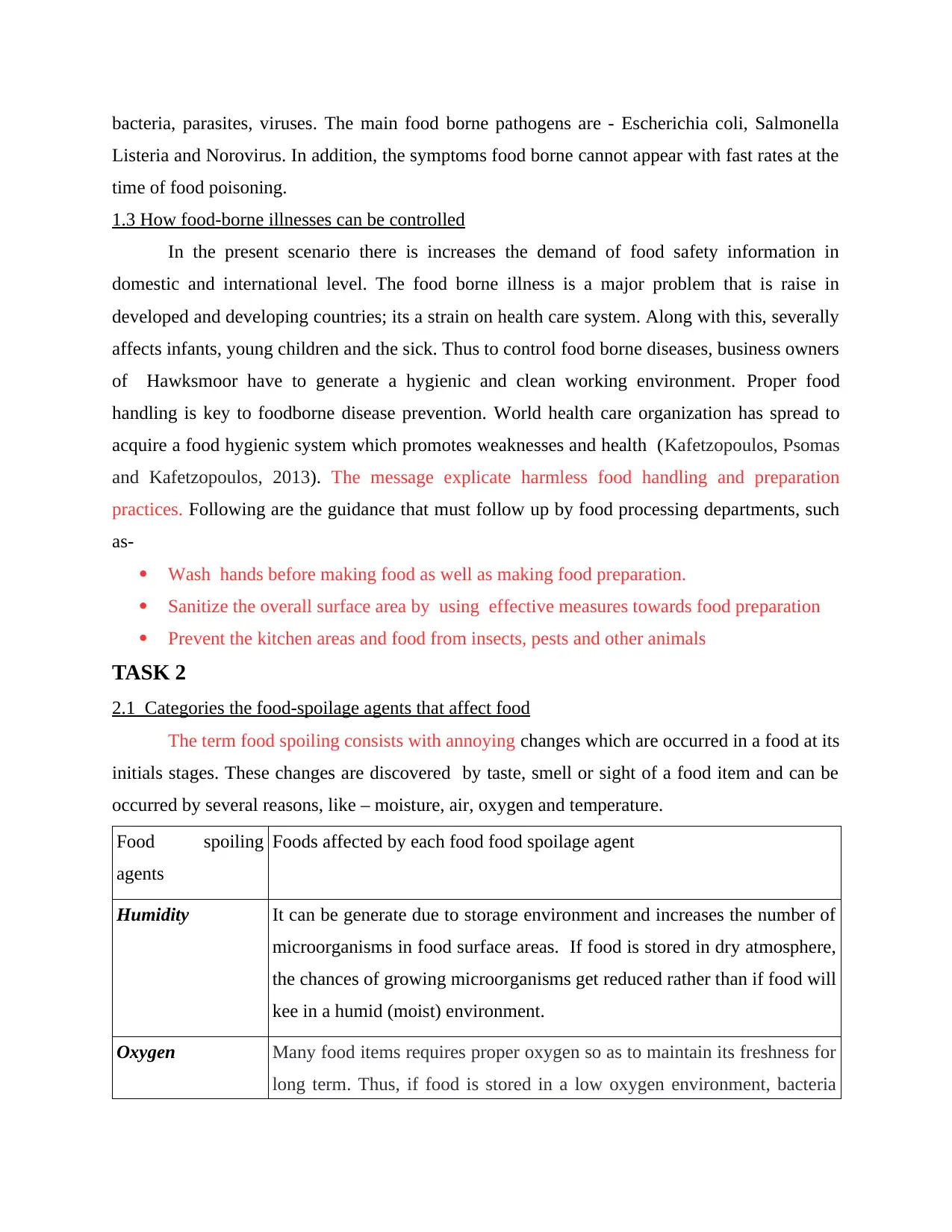
bacteria, parasites, viruses. The main food borne pathogens are - Escherichia coli, Salmonella
Listeria and Norovirus. In addition, the symptoms food borne cannot appear with fast rates at the
time of food poisoning.
1.3 How food-borne illnesses can be controlled
In the present scenario there is increases the demand of food safety information in
domestic and international level. The food borne illness is a major problem that is raise in
developed and developing countries; its a strain on health care system. Along with this, severally
affects infants, young children and the sick. Thus to control food borne diseases, business owners
of Hawksmoor have to generate a hygienic and clean working environment. Proper food
handling is key to foodborne disease prevention. World health care organization has spread to
acquire a food hygienic system which promotes weaknesses and health (Kafetzopoulos, Psomas
and Kafetzopoulos, 2013). The message explicate harmless food handling and preparation
practices. Following are the guidance that must follow up by food processing departments, such
as-
Wash hands before making food as well as making food preparation.
Sanitize the overall surface area by using effective measures towards food preparation
Prevent the kitchen areas and food from insects, pests and other animals
TASK 2
2.1 Categories the food-spoilage agents that affect food
The term food spoiling consists with annoying changes which are occurred in a food at its
initials stages. These changes are discovered by taste, smell or sight of a food item and can be
occurred by several reasons, like – moisture, air, oxygen and temperature.
Food spoiling
agents
Foods affected by each food food spoilage agent
Humidity It can be generate due to storage environment and increases the number of
microorganisms in food surface areas. If food is stored in dry atmosphere,
the chances of growing microorganisms get reduced rather than if food will
kee in a humid (moist) environment.
Oxygen Many food items requires proper oxygen so as to maintain its freshness for
long term. Thus, if food is stored in a low oxygen environment, bacteria
Listeria and Norovirus. In addition, the symptoms food borne cannot appear with fast rates at the
time of food poisoning.
1.3 How food-borne illnesses can be controlled
In the present scenario there is increases the demand of food safety information in
domestic and international level. The food borne illness is a major problem that is raise in
developed and developing countries; its a strain on health care system. Along with this, severally
affects infants, young children and the sick. Thus to control food borne diseases, business owners
of Hawksmoor have to generate a hygienic and clean working environment. Proper food
handling is key to foodborne disease prevention. World health care organization has spread to
acquire a food hygienic system which promotes weaknesses and health (Kafetzopoulos, Psomas
and Kafetzopoulos, 2013). The message explicate harmless food handling and preparation
practices. Following are the guidance that must follow up by food processing departments, such
as-
Wash hands before making food as well as making food preparation.
Sanitize the overall surface area by using effective measures towards food preparation
Prevent the kitchen areas and food from insects, pests and other animals
TASK 2
2.1 Categories the food-spoilage agents that affect food
The term food spoiling consists with annoying changes which are occurred in a food at its
initials stages. These changes are discovered by taste, smell or sight of a food item and can be
occurred by several reasons, like – moisture, air, oxygen and temperature.
Food spoiling
agents
Foods affected by each food food spoilage agent
Humidity It can be generate due to storage environment and increases the number of
microorganisms in food surface areas. If food is stored in dry atmosphere,
the chances of growing microorganisms get reduced rather than if food will
kee in a humid (moist) environment.
Oxygen Many food items requires proper oxygen so as to maintain its freshness for
long term. Thus, if food is stored in a low oxygen environment, bacteria
⊘ This is a preview!⊘
Do you want full access?
Subscribe today to unlock all pages.

Trusted by 1+ million students worldwide
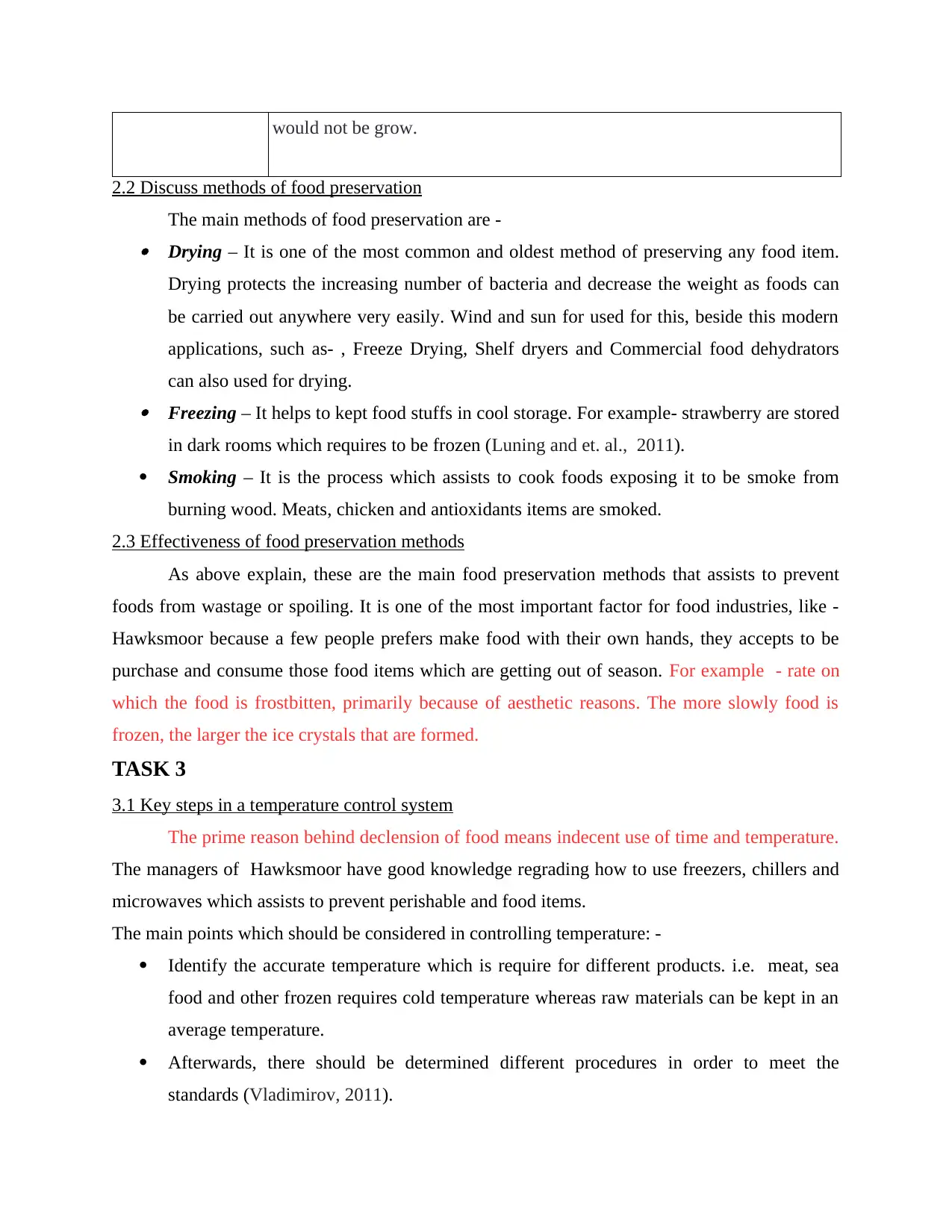
would not be grow.
2.2 Discuss methods of food preservation
The main methods of food preservation are - Drying – It is one of the most common and oldest method of preserving any food item.
Drying protects the increasing number of bacteria and decrease the weight as foods can
be carried out anywhere very easily. Wind and sun for used for this, beside this modern
applications, such as- , Freeze Drying, Shelf dryers and Commercial food dehydrators
can also used for drying. Freezing – It helps to kept food stuffs in cool storage. For example- strawberry are stored
in dark rooms which requires to be frozen (Luning and et. al., 2011).
Smoking – It is the process which assists to cook foods exposing it to be smoke from
burning wood. Meats, chicken and antioxidants items are smoked.
2.3 Effectiveness of food preservation methods
As above explain, these are the main food preservation methods that assists to prevent
foods from wastage or spoiling. It is one of the most important factor for food industries, like -
Hawksmoor because a few people prefers make food with their own hands, they accepts to be
purchase and consume those food items which are getting out of season. For example - rate on
which the food is frostbitten, primarily because of aesthetic reasons. The more slowly food is
frozen, the larger the ice crystals that are formed.
TASK 3
3.1 Key steps in a temperature control system
The prime reason behind declension of food means indecent use of time and temperature.
The managers of Hawksmoor have good knowledge regrading how to use freezers, chillers and
microwaves which assists to prevent perishable and food items.
The main points which should be considered in controlling temperature: -
Identify the accurate temperature which is require for different products. i.e. meat, sea
food and other frozen requires cold temperature whereas raw materials can be kept in an
average temperature.
Afterwards, there should be determined different procedures in order to meet the
standards (Vladimirov, 2011).
2.2 Discuss methods of food preservation
The main methods of food preservation are - Drying – It is one of the most common and oldest method of preserving any food item.
Drying protects the increasing number of bacteria and decrease the weight as foods can
be carried out anywhere very easily. Wind and sun for used for this, beside this modern
applications, such as- , Freeze Drying, Shelf dryers and Commercial food dehydrators
can also used for drying. Freezing – It helps to kept food stuffs in cool storage. For example- strawberry are stored
in dark rooms which requires to be frozen (Luning and et. al., 2011).
Smoking – It is the process which assists to cook foods exposing it to be smoke from
burning wood. Meats, chicken and antioxidants items are smoked.
2.3 Effectiveness of food preservation methods
As above explain, these are the main food preservation methods that assists to prevent
foods from wastage or spoiling. It is one of the most important factor for food industries, like -
Hawksmoor because a few people prefers make food with their own hands, they accepts to be
purchase and consume those food items which are getting out of season. For example - rate on
which the food is frostbitten, primarily because of aesthetic reasons. The more slowly food is
frozen, the larger the ice crystals that are formed.
TASK 3
3.1 Key steps in a temperature control system
The prime reason behind declension of food means indecent use of time and temperature.
The managers of Hawksmoor have good knowledge regrading how to use freezers, chillers and
microwaves which assists to prevent perishable and food items.
The main points which should be considered in controlling temperature: -
Identify the accurate temperature which is require for different products. i.e. meat, sea
food and other frozen requires cold temperature whereas raw materials can be kept in an
average temperature.
Afterwards, there should be determined different procedures in order to meet the
standards (Vladimirov, 2011).
Paraphrase This Document
Need a fresh take? Get an instant paraphrase of this document with our AI Paraphraser
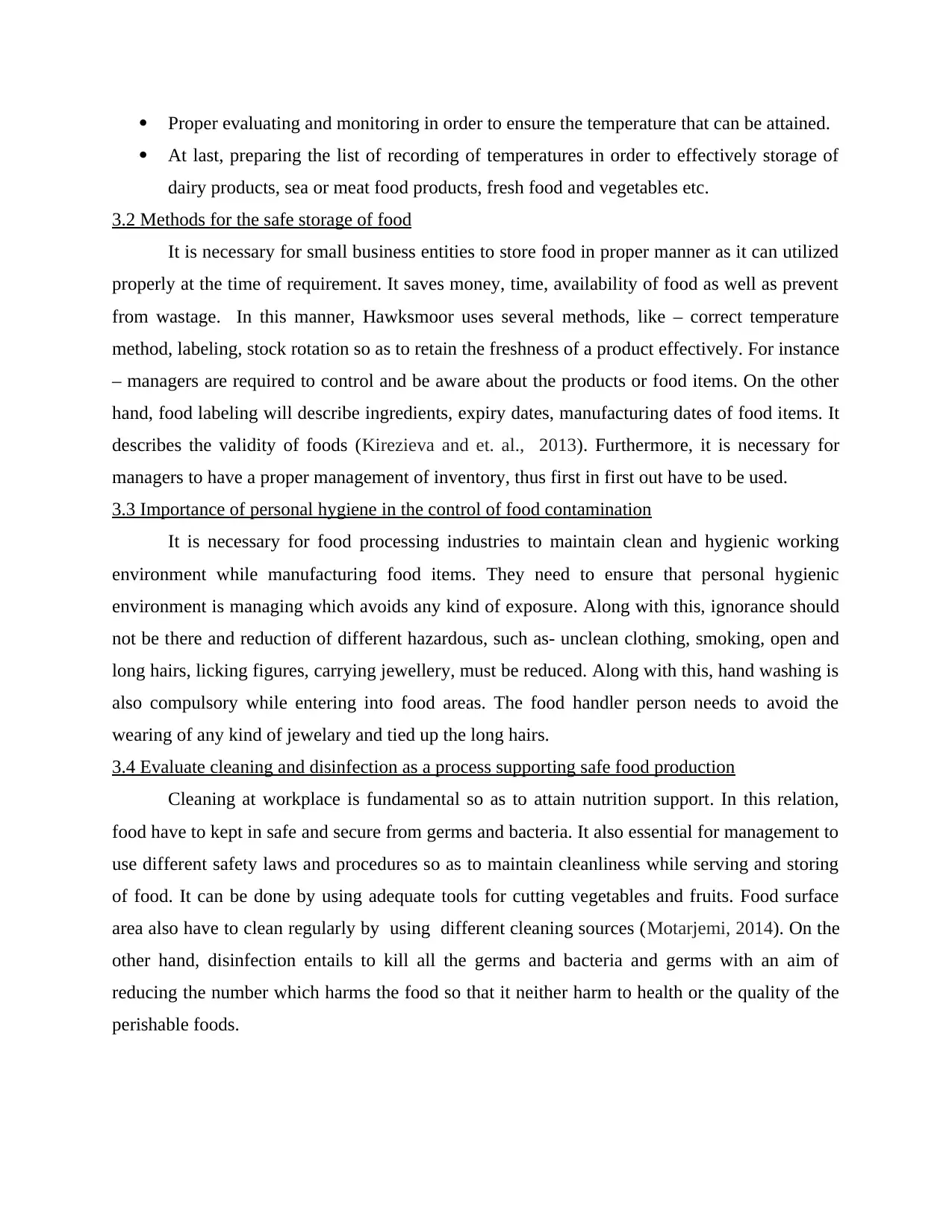
Proper evaluating and monitoring in order to ensure the temperature that can be attained.
At last, preparing the list of recording of temperatures in order to effectively storage of
dairy products, sea or meat food products, fresh food and vegetables etc.
3.2 Methods for the safe storage of food
It is necessary for small business entities to store food in proper manner as it can utilized
properly at the time of requirement. It saves money, time, availability of food as well as prevent
from wastage. In this manner, Hawksmoor uses several methods, like – correct temperature
method, labeling, stock rotation so as to retain the freshness of a product effectively. For instance
– managers are required to control and be aware about the products or food items. On the other
hand, food labeling will describe ingredients, expiry dates, manufacturing dates of food items. It
describes the validity of foods (Kirezieva and et. al., 2013). Furthermore, it is necessary for
managers to have a proper management of inventory, thus first in first out have to be used.
3.3 Importance of personal hygiene in the control of food contamination
It is necessary for food processing industries to maintain clean and hygienic working
environment while manufacturing food items. They need to ensure that personal hygienic
environment is managing which avoids any kind of exposure. Along with this, ignorance should
not be there and reduction of different hazardous, such as- unclean clothing, smoking, open and
long hairs, licking figures, carrying jewellery, must be reduced. Along with this, hand washing is
also compulsory while entering into food areas. The food handler person needs to avoid the
wearing of any kind of jewelary and tied up the long hairs.
3.4 Evaluate cleaning and disinfection as a process supporting safe food production
Cleaning at workplace is fundamental so as to attain nutrition support. In this relation,
food have to kept in safe and secure from germs and bacteria. It also essential for management to
use different safety laws and procedures so as to maintain cleanliness while serving and storing
of food. It can be done by using adequate tools for cutting vegetables and fruits. Food surface
area also have to clean regularly by using different cleaning sources (Motarjemi, 2014). On the
other hand, disinfection entails to kill all the germs and bacteria and germs with an aim of
reducing the number which harms the food so that it neither harm to health or the quality of the
perishable foods.
At last, preparing the list of recording of temperatures in order to effectively storage of
dairy products, sea or meat food products, fresh food and vegetables etc.
3.2 Methods for the safe storage of food
It is necessary for small business entities to store food in proper manner as it can utilized
properly at the time of requirement. It saves money, time, availability of food as well as prevent
from wastage. In this manner, Hawksmoor uses several methods, like – correct temperature
method, labeling, stock rotation so as to retain the freshness of a product effectively. For instance
– managers are required to control and be aware about the products or food items. On the other
hand, food labeling will describe ingredients, expiry dates, manufacturing dates of food items. It
describes the validity of foods (Kirezieva and et. al., 2013). Furthermore, it is necessary for
managers to have a proper management of inventory, thus first in first out have to be used.
3.3 Importance of personal hygiene in the control of food contamination
It is necessary for food processing industries to maintain clean and hygienic working
environment while manufacturing food items. They need to ensure that personal hygienic
environment is managing which avoids any kind of exposure. Along with this, ignorance should
not be there and reduction of different hazardous, such as- unclean clothing, smoking, open and
long hairs, licking figures, carrying jewellery, must be reduced. Along with this, hand washing is
also compulsory while entering into food areas. The food handler person needs to avoid the
wearing of any kind of jewelary and tied up the long hairs.
3.4 Evaluate cleaning and disinfection as a process supporting safe food production
Cleaning at workplace is fundamental so as to attain nutrition support. In this relation,
food have to kept in safe and secure from germs and bacteria. It also essential for management to
use different safety laws and procedures so as to maintain cleanliness while serving and storing
of food. It can be done by using adequate tools for cutting vegetables and fruits. Food surface
area also have to clean regularly by using different cleaning sources (Motarjemi, 2014). On the
other hand, disinfection entails to kill all the germs and bacteria and germs with an aim of
reducing the number which harms the food so that it neither harm to health or the quality of the
perishable foods.
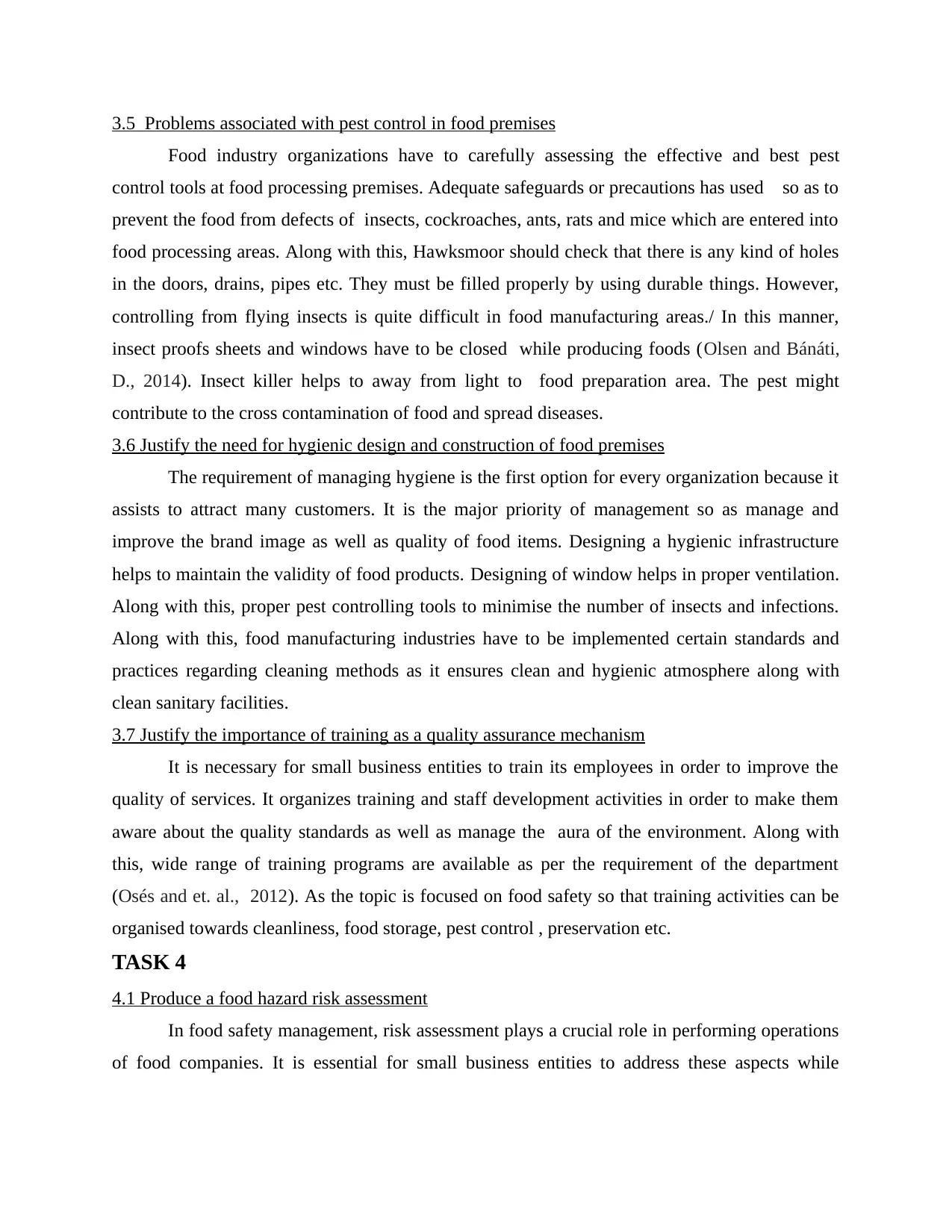
3.5 Problems associated with pest control in food premises
Food industry organizations have to carefully assessing the effective and best pest
control tools at food processing premises. Adequate safeguards or precautions has used so as to
prevent the food from defects of insects, cockroaches, ants, rats and mice which are entered into
food processing areas. Along with this, Hawksmoor should check that there is any kind of holes
in the doors, drains, pipes etc. They must be filled properly by using durable things. However,
controlling from flying insects is quite difficult in food manufacturing areas./ In this manner,
insect proofs sheets and windows have to be closed while producing foods (Olsen and Bánáti,
D., 2014). Insect killer helps to away from light to food preparation area. The pest might
contribute to the cross contamination of food and spread diseases.
3.6 Justify the need for hygienic design and construction of food premises
The requirement of managing hygiene is the first option for every organization because it
assists to attract many customers. It is the major priority of management so as manage and
improve the brand image as well as quality of food items. Designing a hygienic infrastructure
helps to maintain the validity of food products. Designing of window helps in proper ventilation.
Along with this, proper pest controlling tools to minimise the number of insects and infections.
Along with this, food manufacturing industries have to be implemented certain standards and
practices regarding cleaning methods as it ensures clean and hygienic atmosphere along with
clean sanitary facilities.
3.7 Justify the importance of training as a quality assurance mechanism
It is necessary for small business entities to train its employees in order to improve the
quality of services. It organizes training and staff development activities in order to make them
aware about the quality standards as well as manage the aura of the environment. Along with
this, wide range of training programs are available as per the requirement of the department
(Osés and et. al., 2012). As the topic is focused on food safety so that training activities can be
organised towards cleanliness, food storage, pest control , preservation etc.
TASK 4
4.1 Produce a food hazard risk assessment
In food safety management, risk assessment plays a crucial role in performing operations
of food companies. It is essential for small business entities to address these aspects while
Food industry organizations have to carefully assessing the effective and best pest
control tools at food processing premises. Adequate safeguards or precautions has used so as to
prevent the food from defects of insects, cockroaches, ants, rats and mice which are entered into
food processing areas. Along with this, Hawksmoor should check that there is any kind of holes
in the doors, drains, pipes etc. They must be filled properly by using durable things. However,
controlling from flying insects is quite difficult in food manufacturing areas./ In this manner,
insect proofs sheets and windows have to be closed while producing foods (Olsen and Bánáti,
D., 2014). Insect killer helps to away from light to food preparation area. The pest might
contribute to the cross contamination of food and spread diseases.
3.6 Justify the need for hygienic design and construction of food premises
The requirement of managing hygiene is the first option for every organization because it
assists to attract many customers. It is the major priority of management so as manage and
improve the brand image as well as quality of food items. Designing a hygienic infrastructure
helps to maintain the validity of food products. Designing of window helps in proper ventilation.
Along with this, proper pest controlling tools to minimise the number of insects and infections.
Along with this, food manufacturing industries have to be implemented certain standards and
practices regarding cleaning methods as it ensures clean and hygienic atmosphere along with
clean sanitary facilities.
3.7 Justify the importance of training as a quality assurance mechanism
It is necessary for small business entities to train its employees in order to improve the
quality of services. It organizes training and staff development activities in order to make them
aware about the quality standards as well as manage the aura of the environment. Along with
this, wide range of training programs are available as per the requirement of the department
(Osés and et. al., 2012). As the topic is focused on food safety so that training activities can be
organised towards cleanliness, food storage, pest control , preservation etc.
TASK 4
4.1 Produce a food hazard risk assessment
In food safety management, risk assessment plays a crucial role in performing operations
of food companies. It is essential for small business entities to address these aspects while
⊘ This is a preview!⊘
Do you want full access?
Subscribe today to unlock all pages.

Trusted by 1+ million students worldwide
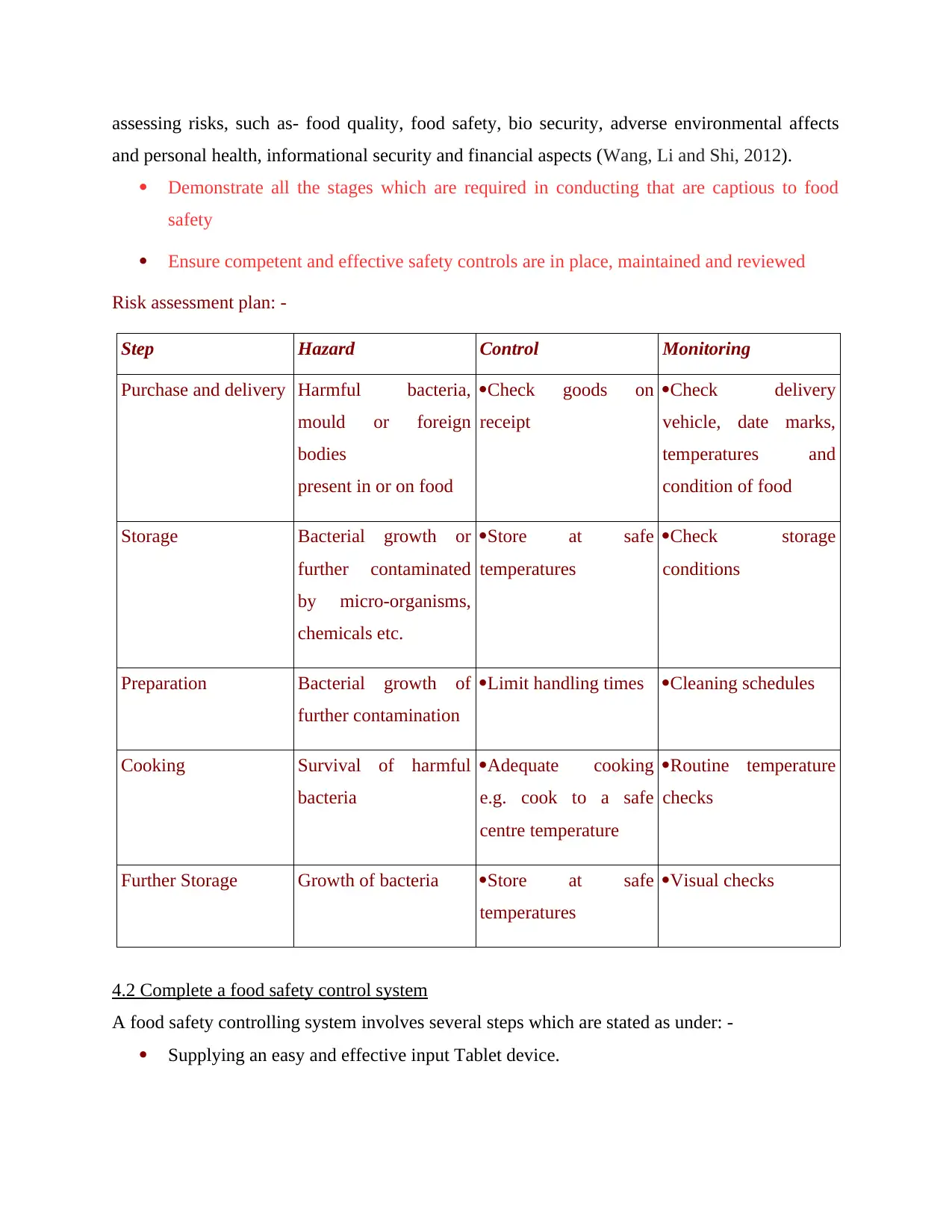
assessing risks, such as- food quality, food safety, bio security, adverse environmental affects
and personal health, informational security and financial aspects (Wang, Li and Shi, 2012).
Demonstrate all the stages which are required in conducting that are captious to food
safety
Ensure competent and effective safety controls are in place, maintained and reviewed
Risk assessment plan: -
Step Hazard Control Monitoring
Purchase and delivery Harmful bacteria,
mould or foreign
bodies
present in or on food
Check goods on
receipt
Check delivery
vehicle, date marks,
temperatures and
condition of food
Storage Bacterial growth or
further contaminated
by micro-organisms,
chemicals etc.
Store at safe
temperatures
Check storage
conditions
Preparation Bacterial growth of
further contamination
Limit handling times Cleaning schedules
Cooking Survival of harmful
bacteria
Adequate cooking
e.g. cook to a safe
centre temperature
Routine temperature
checks
Further Storage Growth of bacteria Store at safe
temperatures
Visual checks
4.2 Complete a food safety control system
A food safety controlling system involves several steps which are stated as under: -
Supplying an easy and effective input Tablet device.
and personal health, informational security and financial aspects (Wang, Li and Shi, 2012).
Demonstrate all the stages which are required in conducting that are captious to food
safety
Ensure competent and effective safety controls are in place, maintained and reviewed
Risk assessment plan: -
Step Hazard Control Monitoring
Purchase and delivery Harmful bacteria,
mould or foreign
bodies
present in or on food
Check goods on
receipt
Check delivery
vehicle, date marks,
temperatures and
condition of food
Storage Bacterial growth or
further contaminated
by micro-organisms,
chemicals etc.
Store at safe
temperatures
Check storage
conditions
Preparation Bacterial growth of
further contamination
Limit handling times Cleaning schedules
Cooking Survival of harmful
bacteria
Adequate cooking
e.g. cook to a safe
centre temperature
Routine temperature
checks
Further Storage Growth of bacteria Store at safe
temperatures
Visual checks
4.2 Complete a food safety control system
A food safety controlling system involves several steps which are stated as under: -
Supplying an easy and effective input Tablet device.
Paraphrase This Document
Need a fresh take? Get an instant paraphrase of this document with our AI Paraphraser
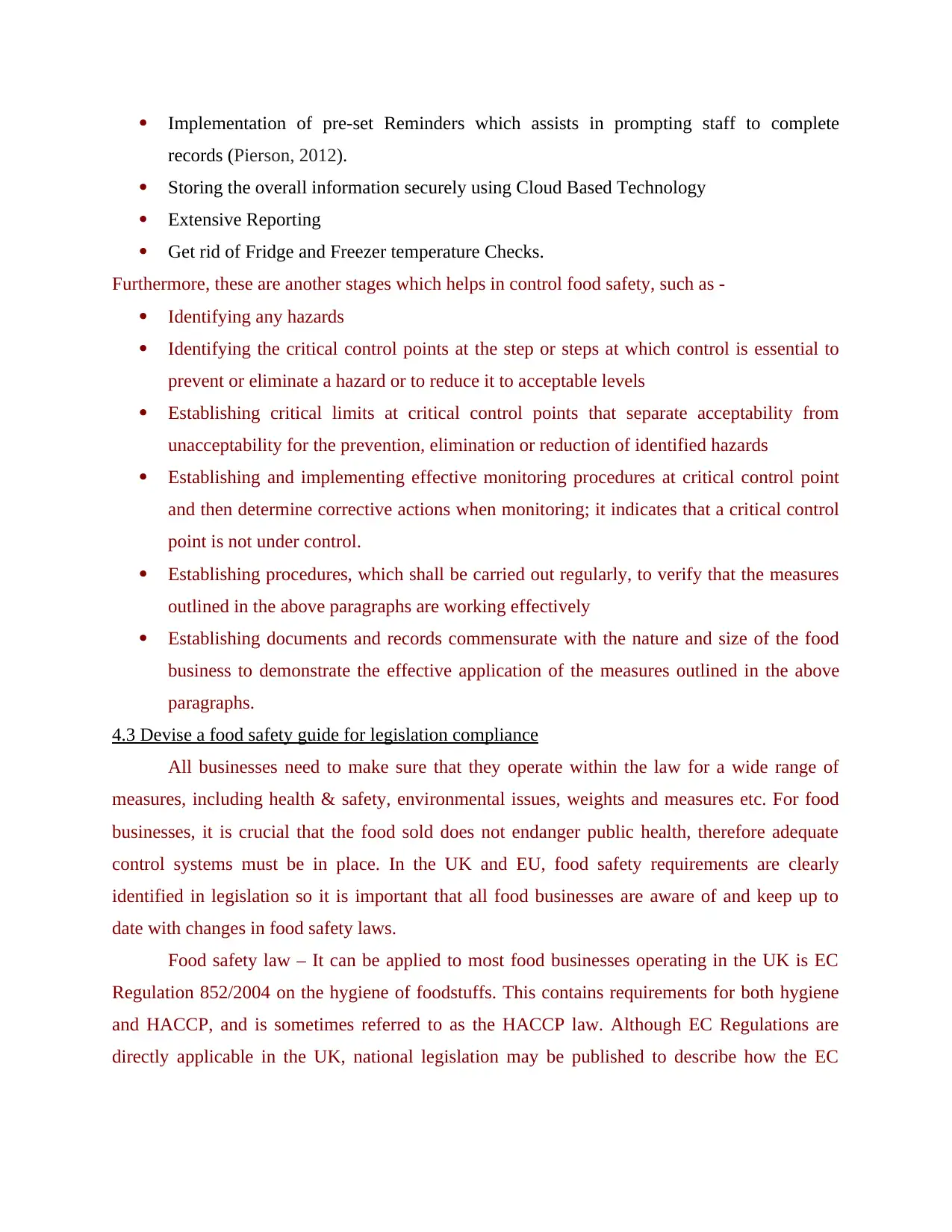
Implementation of pre-set Reminders which assists in prompting staff to complete
records (Pierson, 2012).
Storing the overall information securely using Cloud Based Technology
Extensive Reporting
Get rid of Fridge and Freezer temperature Checks.
Furthermore, these are another stages which helps in control food safety, such as -
Identifying any hazards
Identifying the critical control points at the step or steps at which control is essential to
prevent or eliminate a hazard or to reduce it to acceptable levels
Establishing critical limits at critical control points that separate acceptability from
unacceptability for the prevention, elimination or reduction of identified hazards
Establishing and implementing effective monitoring procedures at critical control point
and then determine corrective actions when monitoring; it indicates that a critical control
point is not under control.
Establishing procedures, which shall be carried out regularly, to verify that the measures
outlined in the above paragraphs are working effectively
Establishing documents and records commensurate with the nature and size of the food
business to demonstrate the effective application of the measures outlined in the above
paragraphs.
4.3 Devise a food safety guide for legislation compliance
All businesses need to make sure that they operate within the law for a wide range of
measures, including health & safety, environmental issues, weights and measures etc. For food
businesses, it is crucial that the food sold does not endanger public health, therefore adequate
control systems must be in place. In the UK and EU, food safety requirements are clearly
identified in legislation so it is important that all food businesses are aware of and keep up to
date with changes in food safety laws.
Food safety law – It can be applied to most food businesses operating in the UK is EC
Regulation 852/2004 on the hygiene of foodstuffs. This contains requirements for both hygiene
and HACCP, and is sometimes referred to as the HACCP law. Although EC Regulations are
directly applicable in the UK, national legislation may be published to describe how the EC
records (Pierson, 2012).
Storing the overall information securely using Cloud Based Technology
Extensive Reporting
Get rid of Fridge and Freezer temperature Checks.
Furthermore, these are another stages which helps in control food safety, such as -
Identifying any hazards
Identifying the critical control points at the step or steps at which control is essential to
prevent or eliminate a hazard or to reduce it to acceptable levels
Establishing critical limits at critical control points that separate acceptability from
unacceptability for the prevention, elimination or reduction of identified hazards
Establishing and implementing effective monitoring procedures at critical control point
and then determine corrective actions when monitoring; it indicates that a critical control
point is not under control.
Establishing procedures, which shall be carried out regularly, to verify that the measures
outlined in the above paragraphs are working effectively
Establishing documents and records commensurate with the nature and size of the food
business to demonstrate the effective application of the measures outlined in the above
paragraphs.
4.3 Devise a food safety guide for legislation compliance
All businesses need to make sure that they operate within the law for a wide range of
measures, including health & safety, environmental issues, weights and measures etc. For food
businesses, it is crucial that the food sold does not endanger public health, therefore adequate
control systems must be in place. In the UK and EU, food safety requirements are clearly
identified in legislation so it is important that all food businesses are aware of and keep up to
date with changes in food safety laws.
Food safety law – It can be applied to most food businesses operating in the UK is EC
Regulation 852/2004 on the hygiene of foodstuffs. This contains requirements for both hygiene
and HACCP, and is sometimes referred to as the HACCP law. Although EC Regulations are
directly applicable in the UK, national legislation may be published to describe how the EC
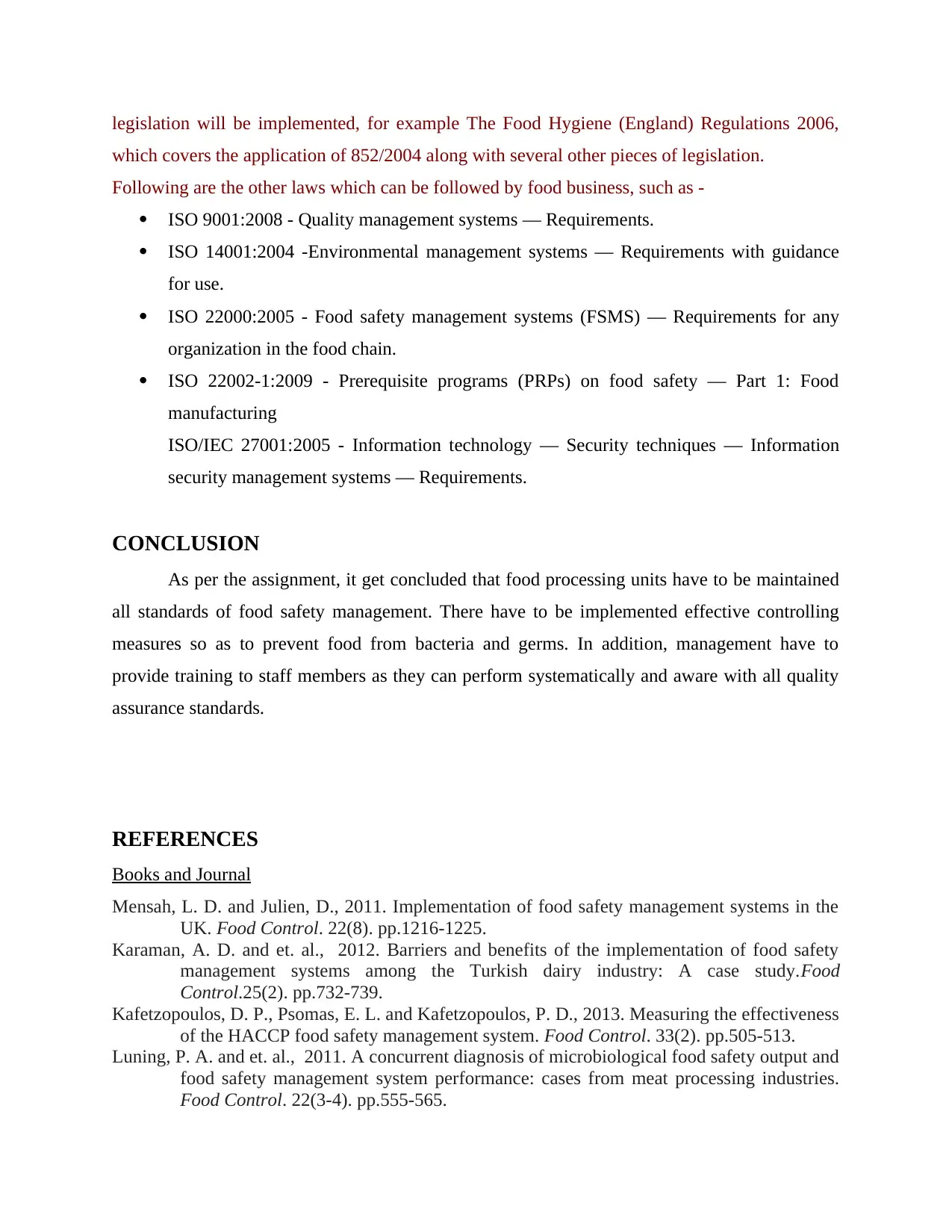
legislation will be implemented, for example The Food Hygiene (England) Regulations 2006,
which covers the application of 852/2004 along with several other pieces of legislation.
Following are the other laws which can be followed by food business, such as -
ISO 9001:2008 - Quality management systems — Requirements.
ISO 14001:2004 -Environmental management systems — Requirements with guidance
for use.
ISO 22000:2005 - Food safety management systems (FSMS) — Requirements for any
organization in the food chain.
ISO 22002-1:2009 - Prerequisite programs (PRPs) on food safety — Part 1: Food
manufacturing
ISO/IEC 27001:2005 - Information technology — Security techniques — Information
security management systems — Requirements.
CONCLUSION
As per the assignment, it get concluded that food processing units have to be maintained
all standards of food safety management. There have to be implemented effective controlling
measures so as to prevent food from bacteria and germs. In addition, management have to
provide training to staff members as they can perform systematically and aware with all quality
assurance standards.
REFERENCES
Books and Journal
Mensah, L. D. and Julien, D., 2011. Implementation of food safety management systems in the
UK. Food Control. 22(8). pp.1216-1225.
Karaman, A. D. and et. al., 2012. Barriers and benefits of the implementation of food safety
management systems among the Turkish dairy industry: A case study.Food
Control.25(2). pp.732-739.
Kafetzopoulos, D. P., Psomas, E. L. and Kafetzopoulos, P. D., 2013. Measuring the effectiveness
of the HACCP food safety management system. Food Control. 33(2). pp.505-513.
Luning, P. A. and et. al., 2011. A concurrent diagnosis of microbiological food safety output and
food safety management system performance: cases from meat processing industries.
Food Control. 22(3-4). pp.555-565.
which covers the application of 852/2004 along with several other pieces of legislation.
Following are the other laws which can be followed by food business, such as -
ISO 9001:2008 - Quality management systems — Requirements.
ISO 14001:2004 -Environmental management systems — Requirements with guidance
for use.
ISO 22000:2005 - Food safety management systems (FSMS) — Requirements for any
organization in the food chain.
ISO 22002-1:2009 - Prerequisite programs (PRPs) on food safety — Part 1: Food
manufacturing
ISO/IEC 27001:2005 - Information technology — Security techniques — Information
security management systems — Requirements.
CONCLUSION
As per the assignment, it get concluded that food processing units have to be maintained
all standards of food safety management. There have to be implemented effective controlling
measures so as to prevent food from bacteria and germs. In addition, management have to
provide training to staff members as they can perform systematically and aware with all quality
assurance standards.
REFERENCES
Books and Journal
Mensah, L. D. and Julien, D., 2011. Implementation of food safety management systems in the
UK. Food Control. 22(8). pp.1216-1225.
Karaman, A. D. and et. al., 2012. Barriers and benefits of the implementation of food safety
management systems among the Turkish dairy industry: A case study.Food
Control.25(2). pp.732-739.
Kafetzopoulos, D. P., Psomas, E. L. and Kafetzopoulos, P. D., 2013. Measuring the effectiveness
of the HACCP food safety management system. Food Control. 33(2). pp.505-513.
Luning, P. A. and et. al., 2011. A concurrent diagnosis of microbiological food safety output and
food safety management system performance: cases from meat processing industries.
Food Control. 22(3-4). pp.555-565.
⊘ This is a preview!⊘
Do you want full access?
Subscribe today to unlock all pages.

Trusted by 1+ million students worldwide
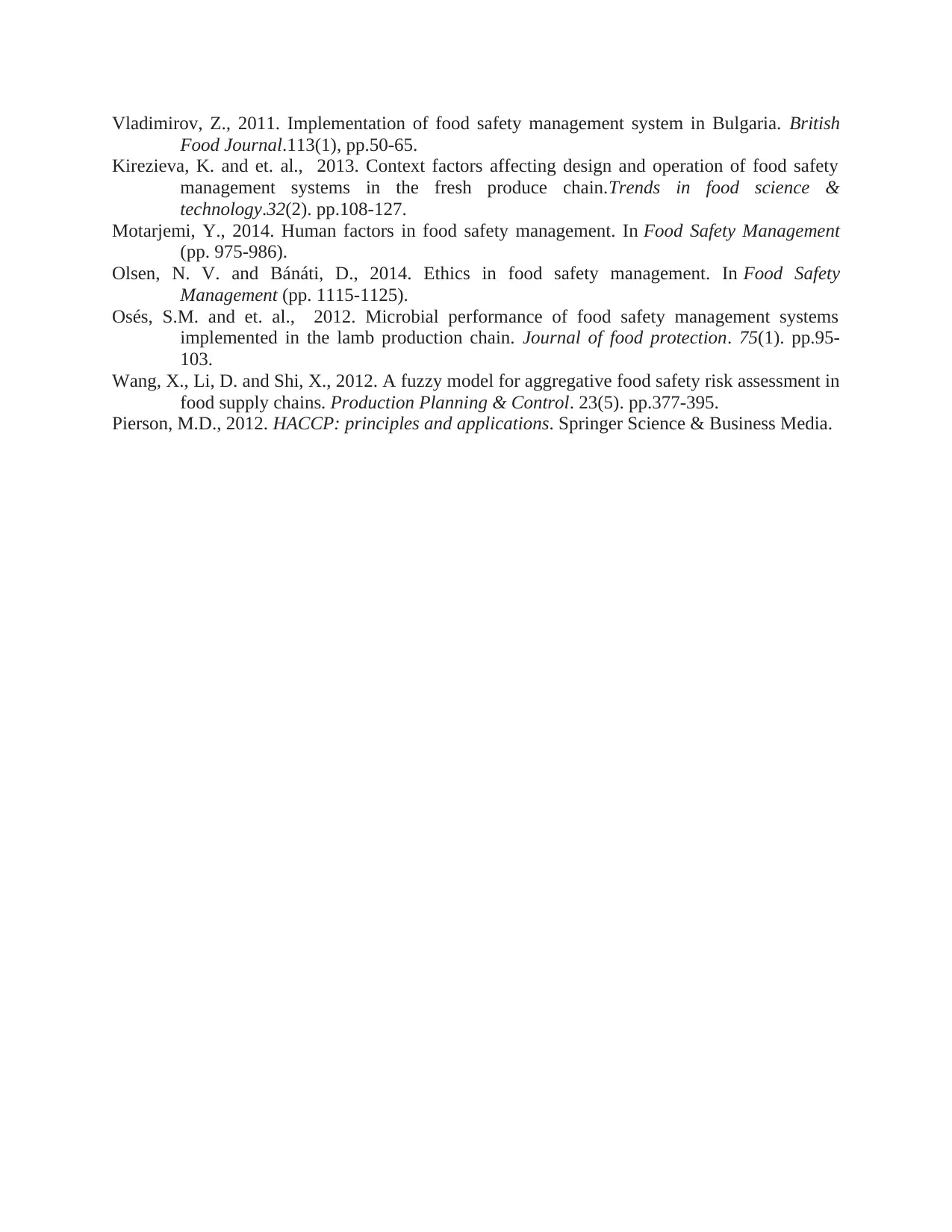
Vladimirov, Z., 2011. Implementation of food safety management system in Bulgaria. British
Food Journal.113(1), pp.50-65.
Kirezieva, K. and et. al., 2013. Context factors affecting design and operation of food safety
management systems in the fresh produce chain.Trends in food science &
technology.32(2). pp.108-127.
Motarjemi, Y., 2014. Human factors in food safety management. In Food Safety Management
(pp. 975-986).
Olsen, N. V. and Bánáti, D., 2014. Ethics in food safety management. In Food Safety
Management (pp. 1115-1125).
Osés, S.M. and et. al., 2012. Microbial performance of food safety management systems
implemented in the lamb production chain. Journal of food protection. 75(1). pp.95-
103.
Wang, X., Li, D. and Shi, X., 2012. A fuzzy model for aggregative food safety risk assessment in
food supply chains. Production Planning & Control. 23(5). pp.377-395.
Pierson, M.D., 2012. HACCP: principles and applications. Springer Science & Business Media.
Food Journal.113(1), pp.50-65.
Kirezieva, K. and et. al., 2013. Context factors affecting design and operation of food safety
management systems in the fresh produce chain.Trends in food science &
technology.32(2). pp.108-127.
Motarjemi, Y., 2014. Human factors in food safety management. In Food Safety Management
(pp. 975-986).
Olsen, N. V. and Bánáti, D., 2014. Ethics in food safety management. In Food Safety
Management (pp. 1115-1125).
Osés, S.M. and et. al., 2012. Microbial performance of food safety management systems
implemented in the lamb production chain. Journal of food protection. 75(1). pp.95-
103.
Wang, X., Li, D. and Shi, X., 2012. A fuzzy model for aggregative food safety risk assessment in
food supply chains. Production Planning & Control. 23(5). pp.377-395.
Pierson, M.D., 2012. HACCP: principles and applications. Springer Science & Business Media.
1 out of 10
Related Documents
Your All-in-One AI-Powered Toolkit for Academic Success.
+13062052269
info@desklib.com
Available 24*7 on WhatsApp / Email
![[object Object]](/_next/static/media/star-bottom.7253800d.svg)
Unlock your academic potential
Copyright © 2020–2025 A2Z Services. All Rights Reserved. Developed and managed by ZUCOL.





